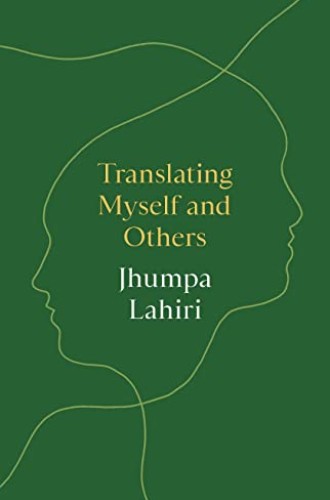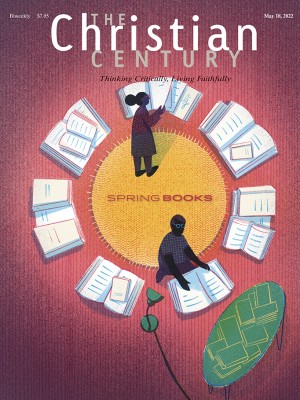Jhumpa Lahiri’s new book crosses boundaries
It doesn’t matter what genre Translating Myself and Others is. What matters is that it is irresistibly immersive.
A book-sized package was waiting on my front step when I opened the door after several hours transfixed to a screen. Finding Translating Myself and Others inside, I meant to leave it on my desk while I went on my daily walk. But a sage female Janus traced on its thick woodland-green jacket, its velvety smoothness and pleasant heft, and the way the cover peeled away revealing more of the hue I call viriditas—all this kept me holding the book.
As I walked past cattails, thistles, egrets, and the liminal space where water meets the shore, Jhumpa Lahiri’s personal essays came alive with wise surprises. As I read, I reflected on my infinity of hours translating Old English, Middle English, and early modern French prose, work that Lahiri names “a metamorphosis: a radical, painful, and miraculous transformation” and “an elaborate, alchemical process that requires imagination, ingenuity, and freedom.” These words moved me profoundly.
Read our latest issue or browse back issues.
I began to wonder: What genre is this boundary-crossing book? The graceful simplicity of Lahiri’s writing—and my windblown outdoor setting—invited a nonlinear progression through the pages, with curiosity leading. No matter your direction through the book, I discovered, its themes and images cohere and sing, richly resonating within itself and beyond, with other books.
Lahiri’s ruminations on translation are relatable and luminous. I jumped into them at the fourth essay, after the words on the back cover by Michael F. Moore (translator of Alessandro Manzoni’s The Betrothed) caught my eye: “Her pages on the myth of Echo are the most poignant and eloquent account of the translator’s art that I have ever read.” In this essay, Lahiri rights past inequities and reassures the soul:
Now that I have become a translator in addition to remaining a writer, I am struck by how many people regard what I am doing as “secondary” and thus creatively inferior in nature. . . . Translators are often described as being invisible, discreet, self-sacrificing presences. Their names are frequently absent on book covers; their roles are meant to be supportive. . . . Indeed, feminist scholars have argued that the practice of translation corresponds to traditional feminine archetypes in which a woman’s position and identity were subservient to a man’s.
Sweeping away centuries of cobwebby thinking, Lahiri replaces it with translation’s stellar essence: “The ongoing, updated echo of translation is critical to sustaining great works of literature, to celebrating and spreading their significance across space and time.” She adds, “The writer who never translates is at a disadvantage in that he or she will be locked, Narcissus-like, for good or for ill, in an ongoing state of self-reflection. . . . For to translate is to look into a mirror and see someone other than oneself.”
Lahiri’s vision of translation as opening to the other brings to mind the words of 20th-century French artist and friar Marie-Alain Couturier, who wrote in Art sacré: “Boundaries must be crossed. We can never cross too many. National boundaries, of course, but first the boundaries of the imagination and of the sensibility, which keep us in cramped jail cells when we think we are so free” (my translation).
Lahiri takes risks, embracing the vulnerability of art making. Recognition came early: her debut short story collection, Interpreter of Maladies, won the Pulitzer Prize when she was 32 years old. Her novel The Lowland was a finalist for the Man Booker Prize and the National Book Award in fiction. She’s received a Guggenheim Fellowship and a National Humanities Medal. She’s translated into English three Italian novels by Domenico Starnone; one of these translations won her the John Florio Prize for Italian translation. She has also written fiction, poetry, and nonfiction in Italian.
This vibrant oeuvre grew from Lahiri’s bicultural background, as she describes in the introduction to Translating Myself and Others: “I was raised speaking and living, simultaneously, in English and Bengali, and this meant translating between them, constantly, for myself and for others.” Her wide-ranging reading nurtures this task—as do her advanced degrees in creative writing, comparative literature, and Renaissance studies.
This book embraces simplicity-in-complexity, making it appropriate for both the Lahiri devotee and the uninitiate wondering how her name’s pronounced (djüm-pə lə-hēr-ē). Its ten main essays in English are lyrical, no matter how many etymologies they praise. Each has a depth of meaning belied by its page count.
In “Why Italian?” Lahiri sifts through her motivations for learning to express herself in another language: “I write in Italian to feel free.” She ties this boundary-crossing activity to human health, saying we need to experience the “nourishment” of other cultures “to move forward, to develop as a society.”
Fed by conversation and multicultural friendships, this volume elevates community. Several essays emerge from Lahiri’s friendship with Starnone, whom she credits with turning her into a traduttrice (translator). Two of the essays are the introductions for her English translations of his novels Ties and Trick; another is the afterword for her English translation of his Trust. The appendix includes Starnone’s Italian translation of Lahiri’s “Where I Find Myself: On Self-Translation.”
I found the book to be irresistibly immersive. Once I was home and near a cup of tea and a screen again, I paused during the second essay, “Containers,” bought a book it discusses, Ties, and read it on Kindle before returning to “Containers.” My one perplexed pause came in the fifth essay, where Lahiri’s discussion surrounding a “young boy” in a Horace poem (book 4, ode 10) could use some complexification in our era of protecting children’s rights.
The thematic anchor of the book is also its longest essay: “Traduzione (stra)ordinaria / (Extra)ordinary Translation,” developed from remarks Lahiri made in Italian for a panel celebrating the publication of Lettere dal carcere (Letters from Prison), by the journalist, philosopher, translator, politician, and Mussolini critic Antonio Gramsci, who was imprisoned for 11 years until his death in 1937. Here readers encounter Gramsci’s suffering for opposing fascism’s “ideology of linguistic purity.” Lahiri describes reading his prison letters methodically, in Italian, and forming a “concrete relationship” with him “as someone—and is this not everyone?—who interrogates history and hopes our world will grow tolerable and just,” learning through him, she says, “just what it means to be free.” This essay’s strange, haunting beauty etched itself into my reflections on the theme of costly freedom, moving me beyond the book’s lovely wisdom and deep into its low chords of grief.
Returning to my query—what genre is this boundary-crossing work?—I found more questions than answers. Is Translating Myself and Others a bible on the art of translation or a humanist manifesto? A memento mori or a treatise on freedom? A long prose poem on mutability or a subversive call to interrogate history’s systems? A hymn to the self-decentering beauty of learning another language or a meditation on the philosophical conundrum of the one and the many? A Burkean-themed primer on the unending conversation of community-strengthening scholarship or a eulogy for the author’s mother? A handbook for teaching active reading or a paean to paradox?
Each of these and more, I decided. Obviously, this is not an ordinary book. It’s more like a snowy egret flying or a long-period comet blazing across the midnight sky. Or a friend.






